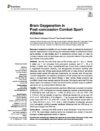Purpose
Investigate the feasibility of a non-invasive method to evaluate the physical and cognitive repercussions of long-lasting post-concussion effects in professional combat sports athletes. To help athletes return to professional combat, there is a need for unbiased objective tools and techniques used as a prognostic method of recovery after Sport Related Concussion (SRC).
Methods
Six mild Traumatic Brain Injury (mTBI) athletes, age 20 ÷ 43 yr (1 female, 5 males) and 7 not concussed (NC) participants (amateur), age 24 ÷ 38 yr (3 females, 4 males), were tested Inspired/expired gas concentration, Cerebral changes in oxygenated haemoglobin (Δ[HbO2]) and deoxygenated haemoglobin (Δ[HHb]) were measured using near infrared spectroscopy (NIRS) with a 3-step protocol: rest before maximal oxygen uptake (VO2max) test, hypercapnia, and recovery after VO2max test. The brain oxygenation and respiratory parameters of both sample sets were calculated using a non-parametric test (Mann-Whitney U test). Aerobic fitness outcome was quantified through mean average using the Bruce test. Participants performed Fitt’s test using a laptop and analysis of medio-lateral and anterior-posterior range of oscillation was carried out via a force platform Romberg test.
Results
mTBI group showed statistically significant differences in saturated haemoglobin Δ[HbO2] (p < 0.001) during rest and recovery phase after maximal incremental exercise, in medio-lateral sway eyes open (p = 0.008, NC 25.35 ± 4.11 mm and mTBI 17.65 ± 4.79 mm). VO2max revealed no significant differences between the two groups: NC 47.47 ± 4.91 mTBI 49.58 ± 5.19 ml/kg/min−1. The 2 groups didn’t differ for maximum power output (NC 220 ± 34, mTBI 255 ± 50 W). End-tidal fractional concentration of O2 (FetO2 NC15.20 ± 0.41, mTBI 16.09 ± 0.68) throughout hypercapnia, saturated blood haemoglobin (Δ[HbO2]) revealed significant differences with the mTBI group. No differences emerged from Fitt’s test.
Conclusions
It emerges that NIRS is able to reveal differences in long time outcomes of mTBI. The medio-lateral variations cannot be considered as a marker of long-term damage in athletes specifically trained for balance.



Responses